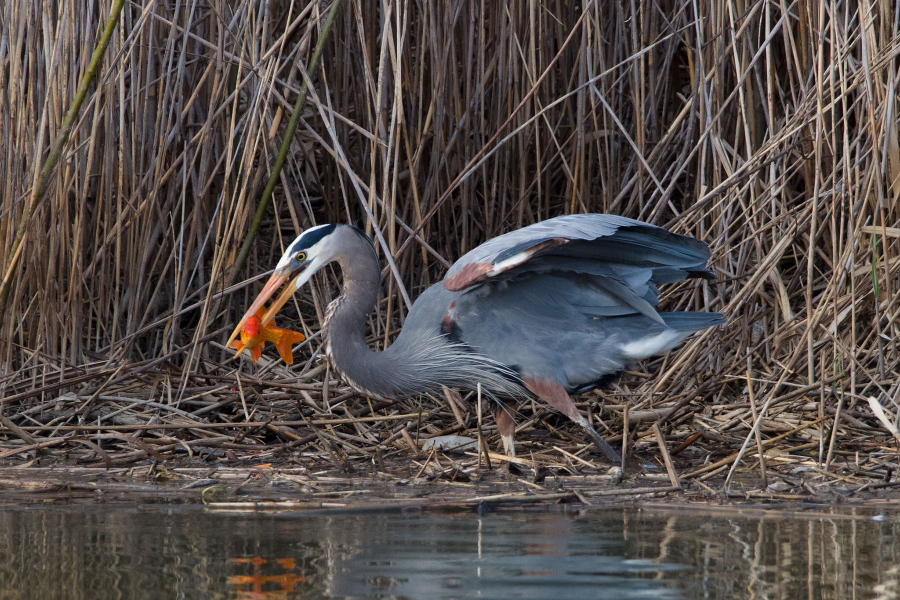Goldfish make themselves at home in the Chesapeake

If you have ever been out on the Bay and seen a familiar flash of orange beneath the water, you might have thought your eyes were playing tricks on you. But there’s a good chance that what you are seeing is very much real.
That’s right: the Chesapeake Bay watershed is home to wild goldfish–and this might not be good news.
How goldfish got here
The goldfish (Carassius auratus) is native to eastern Asia. Once a greyish-brown color, goldfish were selectively bred for centuries in China to achieve the bright orange color they are known for today. They were considered a symbol of good luck, and at one point were exclusively owned by members of the Song Dynasty.
So, how did goldfish go from Chinese royalty to one of America’s most iconic pets? Well, the United States government may have played a role.
In 1878, the United States Commission on Fisheries received the country’s first legal import of goldfish from Japan. The commission gave the goldfish to District of Columbia residents as a publicity stunt, gifting away as many 20,000 goldfish annually.
With the commission's help, goldfish became a national sensation. Touted as a highly affordable and low-maintenance pet, the exotic fish became an increasingly popular addition to aquariums, fountains and ornamental ponds and lakes throughout the country.
The commission could no longer keep up with the growing demand and, in 1889, the country’s first official goldfish farm was established in Maryland. The market for goldfish continued to expand and, by 1893, goldfish were being bred in at least 37 U.S. states.
From popular pet to environmental menace
Goldfish were so cheap to purchase and care for that they quickly developed a reputation for being disposable pets. Owners began dumping their unwanted fish into nearby bodies of water, likely believing that their fish would die of starvation or predation.
Instead, the goldfish thrived and was soon found in the Potomac and Susquehanna rivers, and even the Chesapeake Bay. The Bay’s warm, nutrient-rich waters are ideal for goldfish, containing enough vegetation to supply plenty of food and habitat.
But the goldfish in the Bay don’t look like the fish you win as a carnival prize.
With enough food and room to grow, wild goldfish can balloon to a monstrous five pounds and reach lengths of over 12 inches–roughly the size of a football. Goldfish are rampant, destructive eaters and can easily outcompete the Bay’s native species for food. They dine on algae, underwater grasses, insects, tadpoles, crustaceans, fish eggs and smaller fish, uprooting vegetation, stirring up sediment and destroying native fish habitat as they go.
Because they are an exotic species, goldfish can transfer a variety of foreign bacteria and parasites to the Bay’s native species. Even dead goldfish may still transmit harmful illnesses that can devastate the Bay’s delicate ecosystem.
Goldfish are rapid reproducers. A typical female goldfish produces up to 40,000 eggs in a breeding season. With no naturally occurring predators to keep them in check, goldfish can enter into a vicious cycle of overpopulation and create serious problems for an ecosystem. Goldfish will also breed with their relatives, the common carp, another nonnative species in the Chesapeake Bay.
Goldfish are highly resilient and can adapt to a wide range of environmental conditions, including high turbidity, dramatic changes in temperature and low levels of dissolved oxygen. This puts them at an advantage over the Bay’s native species, which are more sensitive to changes in the Bay ecosystem.
Goldfish populations appear to be growing
“We’re seeing more goldfish this year than any year before,” said Phong Trieu, a senior environmental planner with the Metropolitan Washington City of Governments (COG). Trieu has sampled fish populations in the Anacostia River watershed for 22 years–but he has never seen anything like this.
“Now when we go out on the water, we’re seeing them all around us,” said Trieu.
The explosion of goldfish is likely the result of last year’s record-setting rainfall. In 2018, the Chesapeake Bay saw a dramatic increase in freshwater flow from the Bay’s tributaries. As the deluge of freshwater decreased salinity levels throughout the Bay, goldfish were able to expand their range and establish themselves in new tributaries.
Increased flooding may have also played a significant role in the goldfish’s spread. “There are goldfish are in our stormwater ponds,” said Trieu. “When those stormwater ponds overflow, goldfish get drained into the tributaries.”
Goldfish sightings have not been limited to the Bay’s freshwater systems. A distribution map maintained by the United States Geological Survey shows that goldfish have been observed in brackish waters as well. This spread is particularly concerning for target restoration areas such as the Susquehanna Flats, where goldfish can disrupt the growth of valuable Bay grasses with their destructive feeding habits.
While it is unlikely that goldfish will ever be completely eliminated from the Chesapeake Bay watershed, you can help control their spread by caring for them properly and disposing of them responsibly.
This article originally appeared in the December issue of the Bay Journal.

Comments
I caught a 2 pound goldfish the other day. It does about as much damage as a 2 pound common carp. I live where the Bay and the river come together and fished around Havre de Grace for a long time. I pull out a lot of 20 pound plus carp every year. I wouldn't worry about the goldfish as much as the blue catfish.
I am 73 years old lived in NJ.as a young man along the DEL. river across from PHIL. PA. Have seen several gold fish there. Was fishing there one time and pulled in about a 4 pound gold fish. So ?
Thank you!
Your comment has been received. Before it can be published, the comment will be reviewed by our team to ensure it adheres with our rules of engagement.
Back to recent stories